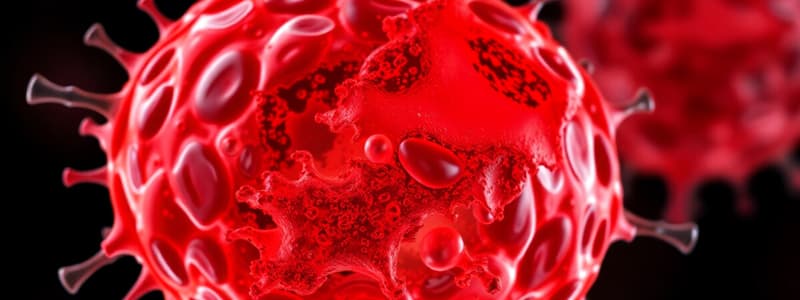Podcast
Questions and Answers
Which of the following is NOT a physical agent that can cause cellular injury?
Which of the following is NOT a physical agent that can cause cellular injury?
- Alcohol (correct)
- Electric shock
- Hypoxia
- Radiations
Which form of adaptation involves an increase in cell size?
Which form of adaptation involves an increase in cell size?
- Hyperplasia
- Metaplasia
- Hypertrophy (correct)
- Atrophy
What type of adaptation occurs in the kidneys after nephrectomy?
What type of adaptation occurs in the kidneys after nephrectomy?
- Hypertrophy
- Hyperplasia (correct)
- Atrophy
- Metaplasia
Which mechanism leads to the change of one type of epithelial cell to another type of epithelial cell?
Which mechanism leads to the change of one type of epithelial cell to another type of epithelial cell?
Which of the following is a cause of hypoxic cell injury?
Which of the following is a cause of hypoxic cell injury?
What type of epithelium replaces the normal ciliated columnar epithelium in response to chronic irritation?
What type of epithelium replaces the normal ciliated columnar epithelium in response to chronic irritation?
What is the result of skeletal muscle atrophy after paralysis?
What is the result of skeletal muscle atrophy after paralysis?
Which of the following is NOT a consequence of tissue hypoxia?
Which of the following is NOT a consequence of tissue hypoxia?
Which type of cell injury involves irreversible damage?
Which type of cell injury involves irreversible damage?
Cigarette smoke primarily induces which type of cellular adaptation in the airways?
Cigarette smoke primarily induces which type of cellular adaptation in the airways?
What effect does hypoxemia have on the body?
What effect does hypoxemia have on the body?
Cell swelling is primarily caused by failure to maintain which of the following?
Cell swelling is primarily caused by failure to maintain which of the following?
Which mechanism is associated with irreversible cell injury?
Which mechanism is associated with irreversible cell injury?
The accumulation of which substance indicates fatty change in cells?
The accumulation of which substance indicates fatty change in cells?
Which of the following is a mechanism leading to reversible cell injury?
Which of the following is a mechanism leading to reversible cell injury?
Flashcards
Reversible Cell Injury
Reversible Cell Injury
Cell injury that the affected cells can recover from.
Irreversible Cell Injury
Irreversible Cell Injury
Cell injury severe enough that the affected cells die; there's no recovery.
Hypoxic Cell Injury
Hypoxic Cell Injury
Cell injury caused by inadequate oxygen supply to tissues.
Consequences of Hypoxia
Consequences of Hypoxia
Signup and view all the flashcards
Cell Swelling
Cell Swelling
Signup and view all the flashcards
Fatty Change
Fatty Change
Signup and view all the flashcards
Chronic Irritation (Cell Injury)
Chronic Irritation (Cell Injury)
Signup and view all the flashcards
Cell Injury Causes
Cell Injury Causes
Signup and view all the flashcards
Hypoxic Injury
Hypoxic Injury
Signup and view all the flashcards
Cellular Adaptation
Cellular Adaptation
Signup and view all the flashcards
Hyperplasia
Hyperplasia
Signup and view all the flashcards
Hypertrophy
Hypertrophy
Signup and view all the flashcards
Atrophy
Atrophy
Signup and view all the flashcards
Metaplasia
Metaplasia
Signup and view all the flashcards
Reversible Cell Injury
Reversible Cell Injury
Signup and view all the flashcards
Study Notes
Cell Injury Overview
- Cells are constantly exposed to stressors.
- Cells initially adapt to overcome stressful conditions.
- Severe or prolonged stress leads to cell injury.
Intended Learning Objectives
- Identify causes of cell injury.
- Describe cellular adaptation with examples.
- Recall types of cell injury.
- Describe reversible cell injury mechanisms and morphology.
- Define, identify causes, and explain consequences of hypoxic cell injury.
- Describe irreversible cell injury mechanisms.
Causes of Cellular Injury
- Physical agents: Hypoxia, mechanical trauma, burns, radiation, electric shock.
- Chemical agents: Poisons (toxins), insecticides, alcohol, tobacco.
- Infectious agents: Viruses, bacteria, fungi, parasites.
- Immunological reactions: Anaphylaxis, autoimmune diseases.
- Genetic derangements: Abnormal proteins (hemoglobinopathies), abnormal or absent enzymes (storage disorders).
Cellular Adaptation
- Hyperplasia: Increase in cell number, e.g., compensatory hyperplasia of the kidney after nephrectomy.
- Hypertrophy: Increase in cell size, e.g., hypertrophy of the left ventricle due to aortic stenosis or hypertension.
- Atrophy: Decrease in cell number and/or size, e.g., skeletal muscle atrophy after paralysis.
- Metaplasia: Change of one cell type to another cell type of the same category, e.g., change from columnar epithelium to squamous epithelium in the airways due to cigarette smoke.
Types of Cell Injury
- Reversible: Affected cells can recover from the injury.
- Irreversible: Affected cell dies.
Hypoxic Cell Injury
- Definition: Inadequate oxygenation of tissue.
- Causes:
- Hypoxemia: Decreased oxygen in the plasma.
- Hemoglobin abnormalities: Anemia.
- Ischemia: Decreased arterial blood flow to tissues (often due to atherosclerosis).
- Consequences:
- Decreased ATP synthesis.
- Impaired Na+/K+-ATPase pump leading to cellular swelling.
- Shift to anaerobic glycolysis leading to lactic acid accumulation, decreased intracellular pH, protein denaturation, and clumping of nuclear chromatin.
- Ribosomal detachment leading to decreased protein synthesis and lipid accumulation (fatty change).
Morphology of Reversible Cell Injury
- Cellular swelling: First manifestation of cell injury; ionic and fluid homeostasis fail.
- Fatty change: Lipid vacuoles within the cytoplasm (seen in the kidney, heart, and liver).
Irreversible Cell Injury
- Mechanism: Persistent or severe injury (hypoxia or anoxia) pushes the cell to the "point of no return" making the injury irreversible.
- Hallmark: Severe mitochondrial damage.
- Mechanism of Mitochondrial Damage: Marked reduction in ATP production leads to mitochondrial damage, high conductance channels (MPT channels) formation, releasing cytochrome c into the cytosol, triggering cell death.
Studying That Suits You
Use AI to generate personalized quizzes and flashcards to suit your learning preferences.




